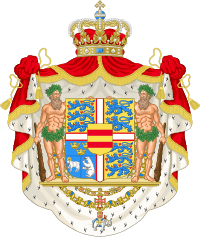Christian X of Denmark
Christian X (Christian Carl Frederik Albert Alexander Vilhelm; 26 September 1870 – 20 April 1947) was King of Denmark from 1912 to 1947, and the only King of Iceland (where the name was officially Kristján X) between 1918 and 1944. He was a member of the House of Glücksburg and the first monarch since King Frederick VII to have actually been born into the Danish royal family; both his father and his grandfather were born as princes of a ducal family from Schleswig. Among his siblings was King Haakon VII of Norway.
| Christian X | |
|---|---|
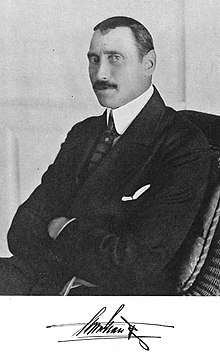 | |
| King of Denmark (more...) | |
| Reign | 14 May 1912 – 20 April 1947 |
| Predecessor | Frederick VIII |
| Successor | Frederick IX |
| Prime Ministers | See list
|
| King of Iceland | |
| Reign | 1 December 1918 – 17 June 1944 |
| Predecessor | Position created |
| Successor | Monarchy abolished Sveinn Björnsson as President of Iceland |
| Prime Ministers | See list
|
| Born | 26 September 1870 Charlottenlund Palace, Copenhagen, Denmark |
| Died | 20 April 1947 (aged 76) Amalienborg Palace, Copenhagen, Denmark |
| Burial | Roskilde Cathedral, Roskilde, Denmark |
| Spouse | Alexandrine of Mecklenburg-Schwerin |
| Issue | Frederick IX of Denmark Knud, Hereditary Prince of Denmark |
| House | Glücksburg |
| Father | Frederick VIII of Denmark |
| Mother | Louise of Sweden |
| Religion | Lutheran |
His character has been described as authoritarian and he strongly stressed the importance of royal dignity and power. His reluctance to fully embrace democracy resulted in the Easter Crisis of 1920, in which he dismissed the democratically elected Social Liberal cabinet with which he disagreed, and instated one of his own choosing. This was in accordance with the letter of the constitution, but the principle of parliamentarianism had been considered a constitutional custom since 1901. Faced with mass demonstrations, a general strike organized by the Social Democrats and the risk of the monarchy being overthrown he was forced to accept that a monarch could not keep a government in office against the will of parliament, as well as his reduced role as a symbolic head of state.
During the German occupation of Denmark, Christian become a popular symbol of resistance, particularly because of the symbolic value of the fact that he rode every day through the streets of Copenhagen unaccompanied by guards. With a reign spanning two world wars, and his role as a rallying symbol for Danish national sentiment during the German occupation, he became one of the most popular Danish monarchs of modern times.
Early life
Christian was born on 26 September 1870 at Charlottenlund Palace in Gentofte Municipality north of Copenhagen, during the reign of his paternal grandfather, King Christian IX. He was born as the oldest son and child of Crown Prince Frederick of Denmark and his wife Louise of Sweden, only surviving child of King Charles XV of Sweden. He was baptised in the Chapel of Christiansborg Palace on 31 October 1870 by the Bishop of Zealand, Hans Lassen Martensen.[1]
After passing the studenter-eksamen (the university entrance examination in Denmark) in 1889 as the first Danish monarch, he started a military education as was customary for princes at that time, and subsequently served with the 5th Dragoon Regiment and later studied at the Officers Academy in Randers from 1891 to 1892.[2]
Marriage

Christian married Alexandrine of Mecklenburg-Schwerin in Cannes on 26 April 1898; she was a daughter of Frederick Francis III, Grand Duke of Mecklenburg-Schwerin, and Grand Duchess Anastasia Mikhailovna of Russia. She eventually became his queen consort. They had two sons:
- Prince Frederick (1899–1972), later King Frederick IX of Denmark
- Prince Knud (1900–1976), later Knud, Hereditary Prince of Denmark
The couple were given Christian VIII's Palace at Amalienborg Palace in Copenhagen as their residence and Sorgenfri Palace north of Copenhagen as a summer residence. Furthermore, the couple received Marselisborg Palace in Aarhus as a wedding present from the people of Denmark in 1898. In 1914, the King also built the villa Klitgården in Skagen.
Crown Prince
On 29 January 1906, King Christian IX died, and Christian's father ascended the throne as King Frederick VIII. Christian himself became crown prince.
Reign
Accession
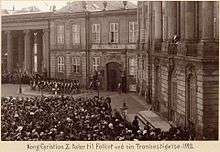
On 14 May 1912, King Frederick VIII died after collapsing from shortness of breath while taking a walk in a park in Hamburg, Germany. He had been returning from a recuperation stay in Nice, France, and was staying anonymously in the city before continuing to Copenhagen. Christian was in Copenhagen when he heard about his father's demise and acceded to the throne as Christian X.
Easter Crisis of 1920
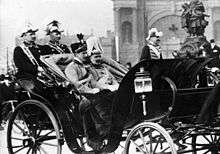
In April 1920, Christian instigated the Easter Crisis, perhaps the most decisive event in the evolution of the Danish monarchy in the Twentieth Century. The immediate cause was a conflict between the King and the cabinet over the reunification with Denmark of Schleswig, a former Danish fiefdom, which had been lost to Prussia during the Second War of Schleswig. Danish claims to the region persisted to the end of World War I, at which time the defeat of the Germans made it possible to resolve the dispute. According to the terms of the Treaty of Versailles, the disposition of Schleswig was to be determined by two plebiscites: one in Northern Schleswig (Denmark's South Jutland County 1971–2006), the other in Central Schleswig (today part of the German state of Schleswig-Holstein). No plebiscite was planned for Southern Schleswig, as it was dominated by an ethnic German majority and, in accordance with prevailing sentiment of the times, remained part of the post-war German state.
In Northern Schleswig, seventy-five percent voted for reunification with Denmark and twenty-five percent for remaining with Germany. In this vote, the entire region was considered to be an indivisible unit, and the entire region was awarded to Denmark. In Central Schleswig, the situation was reversed with eighty percent voting for Germany and twenty percent for Denmark. In this vote, each municipality decided its own future, and German majorities prevailed everywhere. In light of these results, the government of Prime Minister Carl Theodor Zahle determined that reunification with Northern Schleswig could go forward, while Central Schleswig would remain under German control.
Many Danish nationalists felt that at least the city of Flensburg, in Central Schleswig, should be returned to Denmark regardless of the plebiscite's results, due to the sizeable Danish minority there and a general desire to see Germany permanently weakened in the future. Christian X agreed with these sentiments, and ordered Prime Minister Zahle to include Flensburg in the re-unification process. As Denmark had been operating as a parliamentary democracy since the Cabinet of Deuntzer in 1901, Zahle felt he was under no obligation to comply. He refused the order and resigned several days later after a heated exchange with the King.
Subsequently, Christian X dismissed the rest of the cabinet and replaced it with a de facto conservative caretaker cabinet. The dismissal caused demonstrations and an almost revolutionary atmosphere in Denmark, and for several days the future of the monarchy seemed very much in doubt. In light of this, negotiations were opened between the King and members of the Social Democrats. Faced with the potential overthrow of the Danish crown, Christian X stood down and dismissed his own government, installing a compromise cabinet until elections could be held later that year.
To date, this is the last time a sitting Danish monarch has attempted to take political action without the full support of parliament. Following the crisis, Christian X bowed fully to his drastically reduced status, and spent the last quarter-century of his rule as a model constitutional monarch.
World War II
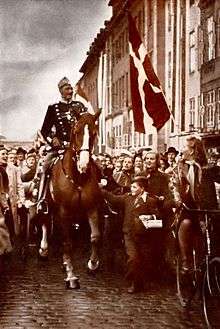
At 4 a.m. on 9 April 1940, Nazi Germany invaded Denmark in a surprise attack, overwhelming Denmark's Army and Navy and destroying the Danish Army Air Corps. Christian X quickly realized that Denmark was in an impossible position. Its territory and population were far too small to hold out against Germany for any sustained period of time. Its flat land would have resulted in it being easily overrun by German panzers; Jutland, for instance, would have been overrun in short order by a panzer attack from Schleswig-Holstein immediately to the south. Unlike its Nordic neighbours, Denmark had no mountain ranges from which a drawn-out resistance could be mounted against the German army.[3] With no prospect of being able to hold out for any length of time, and faced with the explicit threat of the Luftwaffe bombing the civilian population of Copenhagen, and with only one general in favour of continuing to fight, Christian X and the entire Danish government capitulated at about 6 am,[4] in exchange for retaining political independence in domestic matters,[5] beginning the occupation of Denmark, which lasted until 5 May 1945.
In contrast to his brother, King Haakon VII of Norway, and Queen Wilhelmina of the Netherlands, King George II of Greece, Grand Duchess Charlotte of Luxembourg, King Peter II of Yugoslavia, President Edvard Beneš of Czechoslovakia and President Władysław Raczkiewicz of Poland, all of whom went into exile during the Nazi occupation of their countries, Christian X (like King Leopold III of Belgium) remained in his capital throughout the occupation of Denmark, being to the Danish people a visible symbol of the national cause (Haakon escaped the German advance after refusing to accept a Nazi-friendly puppet regime.)
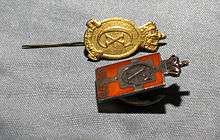
Until the imposition of martial law by Germany in August 1943, Christian's official speeches reflected the government's official policy of cooperation with the occupying forces, but this did not prevent his being seen by the Danish people as a man of "mental resistance." During the first two years of the German occupation, in spite of his age and the precarious situation, he nonetheless took a daily ride on his horse, Jubilee, through Copenhagen, unaccompanied by a groom, let alone by a guard. A popular way for Danes to display patriotism and silent resistance to the German occupation was wearing a small square button with the Danish flag and the crowned insignia of the king.[6] This symbol was called the Kongemærket (King's Emblem pin). In addition, he helped finance the transport of Danish Jews to unoccupied Sweden, where they would be safe from Nazi persecution.[7]
In 1942, Adolf Hitler sent the king a long telegram congratulating him on his seventy-second birthday. The king's reply telegram was a mere, Spreche Meinen besten Dank aus. Chr. Rex (Giving my best thanks, King Christian). This perceived slight, known as the Telegram Crisis, greatly outraged Hitler and he immediately recalled his ambassador from Copenhagen and expelled the Danish ambassador from Germany. German pressure then resulted in the dismissal of the government led by Vilhelm Buhl and its replacement with a new cabinet led by non-party member and veteran diplomat Erik Scavenius, whom the Germans expected to be more cooperative. (In any event, whatever independence Denmark had been able to maintain during the first years of the occupation ended abruptly with the German Putsch in August 1943.) After a fall with his horse on 19 October 1942, he was more or less an invalid for the rest of his reign.[8] The role he played in creating the Easter Crisis of 1920 greatly reduced his popularity, but his daily rides, the Telegram Crisis, and the admiring stories spread by Danish-American circles had once again made him popular to the point of being a beloved national symbol.
Reign over Iceland
The accession of a new Danish–Icelandic Act of Union in late 1918 redefined Iceland, a longtime part of the Danish realm, as a sovereign state in a personal union with the King of Denmark. This made Christian the king of the mostly autonomous Kingdom of Iceland in addition to being King of Denmark. Christian (whose name in Iceland was officially Kristján X) was the first and only monarch to ever reign over Iceland as a sovereign kingdom as opposed to ruling it as a province of a larger kingdom. In 1941, after the German occupation of Denmark and the Allied occupation of Iceland, the Icelandic government concluded that Christian was unable to perform his duties as head of state of Iceland, and thus appointed Sveinn Björnsson as regent to act as provisional head of state. Sveinn had previously been Iceland's ambassador in Copenhagen.
In 1944, while Denmark was still under German occupation, Icelanders voted in a plebiscite to sever all ties with the King of Denmark and to found a republic. Thus, Christian's title as King of Iceland became null and void and Sveinn Björnsson was elected the first President of Iceland by the Icelandic parliament. Christian, who believed that Sveinn had given him assurances that Iceland would not make further moves toward independence while the occupation was ongoing, felt quite badly betrayed. However, at the urging of his relative, the King of Sweden, Christian still accepted the outcome and sent a message of congratulations to Iceland during the celebration of the founding of the Republic on 17 June 1944. The reading of the King's letter provoked cheers at Þingvellir during the celebration. Despite this implicit acceptance of Iceland's independence, Christian never actually stopped using the title "King of Iceland", and continued including it in his regnal name until his death in 1947.
Death
On his death in Amalienborg Palace, Copenhagen, in 1947, Christian X was interred along other members of the Danish royal family in Roskilde Cathedral near Copenhagen. Although he had been behind the politics of Erik Scavenius, a cloth armband of the type worn by members of the Danish resistance movement was placed on his coffin at castrum doloris.[9][10]
Legends
On 22 November 1942, The Washington Post published a photograph of Christian X; calling him, facetiously, a victim of Hitler, and stating that the nation of this monarch did not oppose German occupation with arms.[11] It became then important for Danish Americans to prove the contrary, and a number of stories were invented in the turmoil of the war. The most successful of these was the legend of the King wearing the yellow star in order to support the Jews.[12]
King Christian used to ride daily through the streets of Copenhagen unaccompanied while the people stood and waved to him. One apocryphal story relates that one day, a German soldier remarked to a young boy that he found it odd that the King would ride with no bodyguard. The boy reportedly replied, "All of Denmark is his bodyguard." This story was recounted in Nathaniel Benchley's bestselling book Bright Candles as well as in Lois Lowry's book Number the Stars. The contemporary patriotic song "Der rider en Konge" (There Rides a King) centers on the King's rides. In this song, the narrator replies to a foreigner's inquiry about the King's lack of a guard that "he is our freest man" and that the King is not shielded by physical force but that "hearts guard the king of Denmark."[13]
Another popular, but apocryphal, legend carried by the American press[14] concerned the supposed flying of the German flag over the Hotel d'Angleterre (then being used as the Germany military headquarters in Copenhagen). The King riding by and seeing the flag, tells a German sentry that this is a violation of the armistice agreement and that the flag must be taken down. The sentry replies that this will not be done. The King then says if the flag is not taken down, he will send a Danish soldier to take it down. The sentry responds, "The soldier will be shot." The King replies "the Danish soldier will be me." According to the story, the flag was taken down.
King Christian X became the hero of a number of myths about his defense of the Danish Jews. He became the subject of a persistent urban legend according to which, during Nazi occupation, he donned the Star of David in solidarity with the Danish Jews. Danish Jews were not forced to wear the Star of David. However, the legend likely stems from a 1942 British report that claimed he threatened to don the star if this was forced upon Danish Jews, and was popularised when it was included in Leon Uris's best-selling novel, Exodus.[15]
It is important to note that the King did write in his personal diary this entry: "When you look at the inhumane treatment of Jews, not only in Germany but occupied countries as well, you start worrying that such a demand might also be put on us, but we must clearly refuse such this due to their protection under the Danish constitution. I stated that I could not meet such a demand towards Danish citizens. If such a demand is made, we would best meet it by all wearing the Star of David."[16]
This myth dates back to the Second World War, specifically to a political cartoon, in a Swedish newspaper on 10 January 1942 by Norwegian artist Ragnvald Blix. The myth has been read as a metaphor for the general warm relations that existed between Jewish and non-Jewish Danes.
Honours

King Christian X Land in Greenland is named after him.
- Danish and Icelandic honours[17]
- Knight of the Elephant, 26 September 1888[18]
- Cross of Honour of the Order of the Dannebrog, 26 September 1888
- Commemorative Medal for the Golden Wedding of King Christian IX and Queen Louise
- Order of the Falcon, Founder, 3 July 1921[19]
- Foreign honours[20]

.svg.png)





.svg.png)
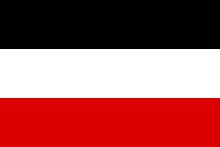
- Knight with Collar of the Black Eagle[18]
- Grand Cross, Order of the Red Eagle
.svg.png)

- Cross of Honour, Order of the Griffon
- Grand Cross with Crown in Ore, House Order of the Wendish Crown

.svg.png)

.svg.png)
- Grand Cross, Order of the Redeemer
- Grand Cross, Order of Saints George and Constantine
.svg.png)
_crowned.svg.png)
.svg.png)
.svg.png)



- Commemorative Medal for the Coronation of King Haakon VII and Queen Maud
- King Haakon VII 1905–1930 Jubilee Medal
- Grand Cross with Collar, Order of St. Olav




- Knight of St. Andrew[18]
- Knight of St. Alexander Nevsky
- Knight of the White Eagle
- Knight 1st Class, Order of St. Anna
- Knight 1st Class, Order of St. Stanislaus
- Knight 4th Class, Order of St. Vladimir
.svg.png)
.svg.png)
- Knight, Order of the Royal House of Chakri
- Commemorative Medal for the Coronation of King Rama VII
.svg.png)
- Grand Cross, Order of Charles III
- Knight of the Golden Fleece, 1901[22]
.svg.png)
- Knight with Collar of the Seraphim, 15 November 1888[18][23]
- Knight of Charles XIII, 1912[24]
- Gold Medal for Commendable Deeds

- Honorary Grand Cross, Royal Victorian Order, 11 October 1901[25]
- Honorary Grand Cross (civil), Order of the Bath, 22 April 1908[26]
- Knight of the Garter, 9 May 1914[27]
- Royal Victorian Chain
- Bailiff Grand Cross of St. John
.svg.png)
Ancestors
| Ancestors of Christian X of Denmark | |||||||||||||||||||||||||||||||||||||||||||||||||||||||||||||||||||||||||||||||||||||||||||||||||||||||||||||||||||||||||||||||||||||||||||||||||||||||||||||||||||||||||||||||||||||||||||||||||||||||||||||||||||||||||||||||||||||||||||||||||||||||||||||||||||||||||||||||||||||||||
|---|---|---|---|---|---|---|---|---|---|---|---|---|---|---|---|---|---|---|---|---|---|---|---|---|---|---|---|---|---|---|---|---|---|---|---|---|---|---|---|---|---|---|---|---|---|---|---|---|---|---|---|---|---|---|---|---|---|---|---|---|---|---|---|---|---|---|---|---|---|---|---|---|---|---|---|---|---|---|---|---|---|---|---|---|---|---|---|---|---|---|---|---|---|---|---|---|---|---|---|---|---|---|---|---|---|---|---|---|---|---|---|---|---|---|---|---|---|---|---|---|---|---|---|---|---|---|---|---|---|---|---|---|---|---|---|---|---|---|---|---|---|---|---|---|---|---|---|---|---|---|---|---|---|---|---|---|---|---|---|---|---|---|---|---|---|---|---|---|---|---|---|---|---|---|---|---|---|---|---|---|---|---|---|---|---|---|---|---|---|---|---|---|---|---|---|---|---|---|---|---|---|---|---|---|---|---|---|---|---|---|---|---|---|---|---|---|---|---|---|---|---|---|---|---|---|---|---|---|---|---|---|---|---|---|---|---|---|---|---|---|---|---|---|---|---|---|---|---|---|---|---|---|---|---|---|---|---|---|---|---|---|---|---|---|---|---|---|---|---|---|---|---|---|---|---|---|---|---|---|---|---|
| |||||||||||||||||||||||||||||||||||||||||||||||||||||||||||||||||||||||||||||||||||||||||||||||||||||||||||||||||||||||||||||||||||||||||||||||||||||||||||||||||||||||||||||||||||||||||||||||||||||||||||||||||||||||||||||||||||||||||||||||||||||||||||||||||||||||||||||||||||||||||
Issue
| Name | Birth | Death | Spouse | Children |
|---|---|---|---|---|
| Frederick IX of Denmark | 11 March 1899 | 14 January 1972 | Princess Ingrid of Sweden | Queen Margrethe II of Denmark Benedikte, Princess of Sayn-Wittgenstein-Berleburg Anne-Marie, Queen of the Hellenes |
| Knud, Hereditary Prince of Denmark | 27 July 1900 | 14 June 1976 | Princess Caroline-Mathilde of Denmark | Princess Elisabeth of Denmark Count Ingolf of Rosenborg Count Christian of Rosenborg |
References
- Allerh. approb. Program for høitidelige Daabshandling i Christiansborg Slotskirke d. 31. Oct 1870 (in Danish). Copenhagen. 1870.
- JENSEN, TINA KNUDSEN. "THORSGADE KASERNE" (in Danish). Retrieved 21 March 2016.
- William Shirer, The Rise and Fall of the Third Reich (New York: Simon & Schuster, 1990), p. 663.
- Peter Rochegune Munch: Erindringer 7, p. 29.
- The German occupation of Denmark Archived 15 October 2013 at the Wayback Machine
- Danish Royal Family (27 November 2012). "The History Behind the King's Emblem". Kongehuset.dk/ (in Danish). The Danish Royal Family. Retrieved 5 February 2017.
- Christian X gav penge til jødetransporter – Kultur | www.b.dk
- FaktaLink – 2005 – Besættelsen – Kilder Archived 10 June 2007 at the Wayback Machine
- "Archived copy" (PDF). Archived from the original (PDF) on 16 July 2011. Retrieved 2011-04-05.CS1 maint: archived copy as title (link)
- Official website of the Danish Monarchy – Biography of King Christian X Archived 25 November 2010 at the Wayback Machine
- Vilhjálmsson, Vilhjálmur Örn (2003). Bastholm Jensen, Mette; Jensen, Steven B. (eds.). "Denmark and the Holocaust". In: Bastholm Jensen, Mette & Steven B. Jensen (Eds.), Denmark and the Holocaust. Published by the Institute for International Studies (Diis), Department for Holocaust and Genocide Studies. Copenhagen. Danish Center for Holocaust and Genocide Studies: 107. Retrieved 5 February 2017.
- United States Holocaust Memorial Museum Frequently asked questions
- "Der rider en Konge". Lyrics by Hans Hartvig Seedorff Pedersen. Published e.g. in Emilius Bangert et al., "Dansk Alsang-Bog", Copenhagen: Egmont H. Peterens Forlag, 1941.
- The Australasian (Melbourne, Vic. : 1864 – 1946). Melbourne, Vic.: National Library of Australia. 21 April 1945. p. 12 http://nla.gov.au/nla.news-article0. Retrieved 21 April 2014. Missing or empty
|title=(help) - Islandsk forsker: Christian X red aldrig med jøde-armbind – Nationalt | www.b.dk
- Christian X var parat til at lade alle bære jødestjerne – Politiken.dk
- Kongelig Dansk Hof-og Statskalendar (1912) (in Danish), "De Kongelig Danske Ridderordener", p. 4
- Justus Perthes, Almanach de Gotha 1922 (1922) page 34
- "The Order of the Falcon". Website of the President of Iceland. English.forseti.is. Archived from the original on 10 September 2012. Retrieved 1 July 2012.
- Kongelig ... Statskalendar (1943) (in Danish), "De Kongelig Danske Ridderordener", pp. 77-78
- "Ordinul Carol I" [Order of Carol I]. Familia Regală a României (in Romanian). Bucharest. Retrieved 17 October 2019.
- Boettger, T. F. "Chevaliers de la Toisón d'Or - Knights of the Golden Fleece". La Confrérie Amicale. Retrieved 25 June 2019.
- "Sveriges statskalender (1925), p. 807". runeberg.org (in Swedish). Retrieved 6 January 2018.
- "Sveriges statskalender (1940), p. 345". runeberg.org (in Swedish). Retrieved 6 January 2018.
- "No. 27364". The London Gazette. 11 October 1901. p. 6640.
- "No. 28131". The London Gazette. 24 April 1908. p. 3077.
- "Knights of the Garter created during the reign of King George V (1910–1936)"Archived 7 August 2018 at the Wayback Machine, Cracroft's Peerage: The Complete Guide to the British Peerage & Baronetage. Retrieved 2018-08-07.
External links
| Wikimedia Commons has media related to Christian X of Denmark. |
- The Royal Lineage at the website of the Danish Monarchy
- Christian X at the website of the Royal Danish Collection at Amalienborg Palace
- Newspaper clippings about Christian X of Denmark in the 20th Century Press Archives of the ZBW
Christian X House of Schleswig-Holstein-Sonderburg-Glücksburg Cadet branch of the House of Oldenburg Born: 26 September 1870 Died: 20 April 1947 | ||
| Regnal titles | ||
|---|---|---|
| Preceded by Frederick VIII |
King of Denmark 1912–1947 |
Succeeded by Frederick IX |
| New title Kingdom of Iceland created |
King of Iceland 1918–1944 |
Vacant Republic of Iceland created |
